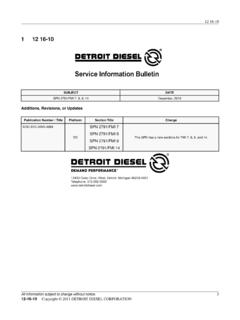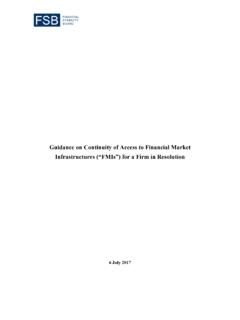Transcription of Absorption Spectra Measurements for the Ozone Molecule …
1 Journal of Atmospheric Chemistry 30: 291 299, 1998. 291. 1998 Kluwer Academic Publishers. Printed in the Netherlands. Absorption Spectra Measurements for the Ozone Molecule in the 350 830 nm Region J. BRION, A. CHAKIR, J. CHARBONNIER, D. DAUMONT, C. PARISSE and J. MALICET. Laboratoire de Chimie Physique, Groupe de Spectrom trie Mol culaire et Atmosph rique, UPRESA Q 6089,? Facult des Sciences, 1039, 51687 Reims Cedex 2, France (Received: 30 July 1997; in final form: 28 January 1998). Abstract. Absolute Absorption cross-sections of Ozone have been measured at ambient (295 K) and low temperature (218 K) in the visible region corresponding to the Chappuis bands. The temperature effect has been studied and found to be very small. The minimum of the Absorption between the Hartley and the Chappuis bands is observed for the first time at 377,5 nm. Key words: Ozone , Absorption cross-sections, Chappuis bands. 1. Introduction Owing to its ability to filter the solar UV radiation, it is well known that Ozone is the most important Molecule in the terrestrial atmosphere.
2 To study atmospheric trend, and more specifically to determine the Ozone concentrations either by direct in situ Measurements or by modelling, it is necessary to know the accurate values of its absolute Absorption cross-section in the UV-visible wavelength regions. For the last years, work has been made in our laboratory to improve these values. At present, we can propose a large set of accurate values in the range 195 830 nm at different temperatures. The first results concerned the most intense bands in the UV region (Hartley and Huggins bands located between 195 and 350 nm) and have been the object of several previous papers (Daumont et al., 1992; Malicet et al., 1995). These values have been obtained at different temperatures (218, 228, 243, 273 and 295 K). usually prevailing in the troposphere and in the stratosphere. In this paper, recent Measurements are presented for the Chappuis band between 420 and 830 nm at ambient temperature and between 515 and 650 nm at 218 K.
3 And for the low Absorption region 350 420 nm between the Huggins band and the Chappuis band at ambient temperature. The Chappuis band shows a large continuum with two maximum absorptions ( = 10 21 cm2 at 575 nm and = 10 21 cm2 at 603 nm) over- lapped by diffuse vibrational structure. For this region discrepancies up to 10%. ? Unit e Propre de Recherche et d'Enseignement Sup erieur Associ ee au CNRS. 292 J. BRION ET AL. between the results of previous authors are observed. Disagreements also exist for the temperature effect which can vary from 0 to 12%. In the spectral region 350 420 nm located between the Huggins and the Chap- puis bands, the Absorption cross-section values are very weak (10 23 10 24 cm2 ). Owing to the experimental difficulties in the Measurements of low Absorption cross- sections, this region was not investigated up to now. It also consists of a contin- uum overlapped by diffuse vibrational bands belonging to the Huggins system for the wavelengths lower than 375 nm and to the Chappuis system for the higher wavelengths.
4 Though the 350 800 nm region is hardly concerned with the problem of the solar attenuation, the knowledge of the Absorption cross-section values in this re- gion is required for in situ concentration Measurements of other species in the atmosphere. In fact these Measurements based on differential techniques require subtracting the Ozone Absorption from the recorded Spectra to determine their con- centration. 2. Experimental The technique for the Measurements of the Ozone Absorption cross-sections has been described in previous papers (Daumont et al., 1992; Malicet et al., 1995). It will be briefly reviewed in this section. The Absorption cross-section value is determined by the Beer-Lambert law ap- plied to a perfect gas at pressure P and temperature T according to: D RT. = , PO3 ` N. where ` = cell optical path R = Perfect gas constant N = Avogadro number PO3 = Ozone partial pressure D = `n(I o/I ) = Optical density Monochromatic light ( nm FWHM) is obtained with a HR 640 Jobin Yvon monochromator.
5 The emerging beam is split into a working beam passing through the Absorption cell and a reference beam, the reference beam measured just after the splitting to take into account the drifts and shifts of the Absorption source. Since the Absorption cross-sections of Ozone are weak for the wavelengths above 350 nm, we have used a 1 m coolable multiple path cell in stainless steel, this material being well suited for a corrosive gas such as Ozone . The alignment of the mirrors at the ends of the cell is achieved by driving motors located outside the cell to avoid contact with Ozone . Path lengths up to 92 m can be obtained. To have the best optical density conditions (between and 2) the Ozone pressure Absorption Spectra Measurements FOR THE Ozone Molecule 293. and the Absorption length are adjusted for each scanning region according to the mean cross-section value of Ozone in that region. The photoabsorption Spectra are then recorded several times and added in order to limit the noise and to increase the accuracy of the Measurements .
6 The standard deviation between these scans remains, for the whole spectral region, between 0,9 and 2%. Ozone is obtained following the procedure previously described by Griggs (1968) from a known initial pressure of molecular oxygen (PO2 )i using a 400 Hz . 15000 V discharge applied between the copper electrodes of an ozonizer according to the global equation: 3 O2 2 O3 . The ozonizer is cooled in liquid nitrogen and, at the corresponding temperature, Ozone is a blue indigo metastable liquid. As soon as the whole amount of oxygen has been transformed, Ozone is warmed and spread out in the Absorption cell. Then, the pressure of the gas mixture (O3 , O2 ) is measured by a capacitif manometer (MKS-BARATRON) with a relatively accuracy 1P /P better than 0,1%. For experiments lasting several hours, the temperature and the total pressure (PT ) in the cell are measured at steady time intervals. These Measurements enable the knowledge of the partial pressure of Ozone in the cell at any time, using the equation: PO3 = 2[(PO2 )i PT ].
7 This formula takes into account the thermal decomposition and the photolysis of Ozone into oxygen. Branching reactions can be neglected, since the concentration of trace gases such as H2 O, CO, CO2 and N2 O, determined by FTIR, is lower than In this case, the Ozone concentration in the Absorption cell is determined at any time from the measurement of the total pressure. This method provides an actual improvement for the determination of the cross-section values, as compared to most of the other works. The experiments have been performed at ambient temperature (295 K) for the whole region, and at 218 K for the 515 650 nm range. A circuit containing metha- nol and immersed in the tank of a 200 ` cryostat is connected to the cell to provide the low temperature. The cell is insulated with an Armaflex foam layer and insu- lation caps fitted at both ends of the cell are pumped to avoid condensation on the windows for the entrance and exit of the light.
8 The temperature is then measured by several Pt sensors (accuracy 0,05 K). At low temperatures, the temperature deviations between the different parts of the cell remain below degree and the stability related to time is better than C. 294 J. BRION ET AL. Figure 1. Ozone cross-sections (515 650 nm). 3. Results The cross-section values have been determined for the whole 350 830 spectral region by steps of nm and are available on request to the authors either by e-mail, or on floppy disk. The photoabsorption spectrum (Figures 1 and 2) appears as a broad continuum, covering the whole visible spectral range with two maxima located at 575 and 603 nm. Important vibrational structure, superimposed on the continuum, belongs to the Chappuis bands (Spectral region: 375 603 nm), to the Huggins bands (below 375 nm) and to the Wulf System (beyond 700 nm) which continues fairly far into the near A deep minimum is shown, for the first time at 377,5 nm ( = 4, 4 10 24.)
9 2. cm ), between the Huggins Bands and the Chappuis System. ERROR BUDGET. The uncertainty on the cross-sections has been estimated from the accuracy on the Measurements of the different parameters involved (see Part 2 Experimental and Table I). The error 1 / , in connection with the uncertainty in wavelength (1 = nm) has been determined for each spectral region. In the Chappuis Band, where the vibrational structure is smooth, this error is small (0,1%). On the contrary in Absorption Spectra Measurements FOR THE Ozone Molecule 295. Figure 2. Ozone cross-sections (350 820 nm). Table I. Error budget 1 . Error origin (%).. Optical density 1% (420 830 nm). 1 3% (350 420 nm). Optical path Ozone pressure Temperature (T = 295 K). (T = 218 K). Impurities < Wavelength (420 830 nm). (350 420 nm). Total systematic error (420 830 nm). 4% (350 420 nm). Random error (RMS) 2%. 296 J. BRION ET AL. the Huggins bands, this error is fairly strong ( ) on account of the important vibrational structure and the strong variation of with wavelengths.
10 Finally, the uncertainty on the optical density 1D/D has been calculated from signal/noise ratios of different scans and is about 1% for the whole spectrum, ex- cept in the 360 420 nm region where the values are very small and the noise important (1D/D from 1 to 3%). In these conditions, the total uncertainty is about 1,5% for the Chappuis band region and about 4% near the Absorption minimum. COMPARISONS. For the visible region, there are numerous references about experimental measure- ments; some of them are very old since the first Absorption spectrum (between 520 and 650 nm) was observed by Chappuis (1880) at the end of last century. Then, Measurements were made by Humphrey and Badger (1947 and 1953), Vassy (1948) and Vigroux (1953 and 1969). More recently Inn and Tanaka (1968), Griggs (1968), Penney (1979), Amoruso (1990), and Anderson and Mauersberger (1992. and 1993) at a few wavelengths, and Burkholder and Talukdar (1994) have recon- sidered these works to propose more precise data sets.





